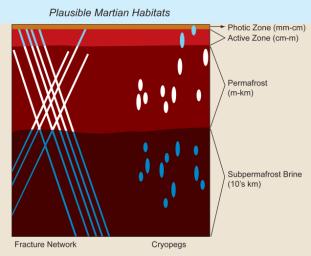
|
Plausible Martian Habitats
- Click the image above for a larger view
- Full-Res JPEG (2240 x 1843) (250.7 kB)
- Full-Res TIFF (2240 x 1843) (12.4 MB)
Caption:
Unfrozen brine in cryopegs and fracture networks provides habitats for the survival and growth of organisms both within and under frozen rocky materials on Earth and, by analogy, could provide habitats on Mars. Cryopegs are isolated lenses or pockets of highly saline, liquid water that is permanently subzero (Celsius) in temperature due to chilling by the surrounding permafrost.
The search for unfrozen Martian niches has expanded with the discovery of seasonally recurring linear features on slopes which might or might not be associated with cryopegs.
On this graphic, mm-cm refers to depths below the ground surface of millimeters to centimeters in vertical scale (fractions of an inch); cm-m refers to depths of centimeters to meters scale (half an inch to several yards); m-km refers to depths of meters to kilometers scale (a yard to a few miles); and 10's km refers to depth of tens of kilometers (several miles or more).
Background Info:
Other imagery related to these new findings from the Mars Reconnaissance Orbiter is at http://www.nasa.gov/mission_pages/MRO/multimedia/gallery/gallery-index.html .
Cataloging Keywords:
| Name | Value | Additional Values |
|---|---|---|
| Target | Mars | |
| System | ||
| Target Type | Planet | |
| Mission | Mars Reconnaissance Orbiter (MRO) | |
| Instrument Host | Mars Reconnaissance Orbiter | |
| Host Type | Orbiter | |
| Instrument | ||
| Detector | ||
| Extra Keywords | Color, Water | |
| Acquisition Date | ||
| Release Date | 2009-10-13 | |
| Date in Caption | ||
| Image Credit | NASA/Indiana University | |
| Source | photojournal.jpl.nasa.gov/catalog/PIA14471 | |
| Identifier | PIA14471 | |
